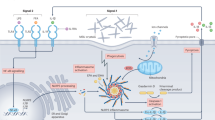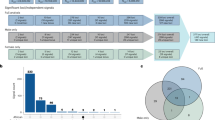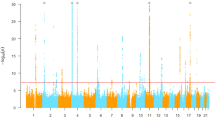Abstract
This study aimed to identify functional associations of cis-regulatory regions with gout susceptibility using data resulted from a genome-wide association study (GWAS), and to show a genetic architecture for gout with interaction effects among genes within each of the identified functions. The GWAS was conducted with 8314 control subjects and 520 patients with gout in the Korea Association REsource cohort. However, genetic associations with any individual nucleotide variants were not discovered by Bonferroni multiple testing in the GWAS (P>1.42 × 10−7). Genomic regions enrichment analysis was employed to identify functional associations of cis-regulatory regions. This analysis revealed several biological processes associated with gout susceptibility, and they were quite different from those with serum uric acid level. Epistasis for susceptibility to gout was estimated using entropy decomposition with selected genes within each biological process identified by the genomic regions enrichment analysis. Some epistases among nucleotide sequence variants for gout susceptibility were found to be larger than their individual effects. This study provided the first evidence that genetic factors for gout susceptibility greatly differed from those for serum uric acid level, which may suggest that research endeavors for identifying genetic factors for gout susceptibility should not be heavily dependent on pathogenesis of uric acid. Interaction effects between genes should be examined to explain a large portion of phenotypic variability for gout susceptibility.
Similar content being viewed by others
Log in or create a free account to read this content
Gain free access to this article, as well as selected content from this journal and more on nature.com
or
References
Roddy, E., Zhang, W. & Doherty, M. Is gout associated with reduced quality of life? A case–control study. Rheumatology 46,, 1441–1444 (2007).
Lee, S. J., Hirsch, J. D., Terkeltaub, R., Khanna, D., Singh, A. J., Andrew, S. et al. Perceptions of disease and health-related quality of life among patients with gout. Rheumatology 48, 582–586 (2009).
Richette, P. & Bardin, T. Gout. Lancet 375, 318–328 (2010).
So, A. & Thorens, B. Uric acid transport and disease. J. Clin. Invest. 120, 1791–1799 (2010).
Dehghan, A., Kottgen, A., Yang, Q., Hwang, S. J., Kao, W. L., Rivadeneira, F. et al. Association of three genetic loci with uric acid concentration and risk of gout: a genome-wide association study. Lancet 372, 1953–1961 (2008).
Doring, A., Gieger, C., Mehta, D., Prokisch, H., Coassin, S., Fischer, G. et al. SLC2A9 influences uric acid concentrations with pronounced sex-specific effects. Nat. Genet. 40, 430–436 (2008).
Vitart, V., Rudan, I., Hayward, C., Gray, N. K., Floyd, J., Palmer, C. N. et al. SLC2A9 is a newly identified urate transporter influencing serum urate concentration, urate excretion and gout. Nat. Genet. 40, 437–442 (2008).
Woodward, O. M., Köttgen, A., Coresh, J., Boerwinkle, E., Guggino, W. B. & Köttgen, M. Identification of a urate transporter, ABCG2, with a common functional polymorphism causing gout. Proc. Natl Acad. Sci. USA 106, 10338–10342 (2009).
Urano, W., Taniguchi, A., Anzai, N., Inoue, E., Kanai, Y., Yamanaka, M. et al. Sodium-dependent phosphate co-transporter type 1 sequence polymorphisms in male patients with gout. Ann. Rheum. Dis. 69, 1232–1234 (2010).
Graessler, J., Graessler, A., Unger, S., Kopprasch, S., Tausche, A. K., Kuhlisch, E. et al. Association of the human urate transporter 1 with reduced renal uric acid excretion and hyperuricemia in a German Caucasian population. Arthritis Rheum. 54, 292–300 (2006)).
Vázquez-Mellado, J., Jiménez-Vaca, A. L., Cuevas-Covarrubias, S., Alvarado-Romano, V., Pozo-Molina, G. & Burgos-Vargas, R. Molecular analysis of the SLC22A12 (URAT1) gene in patients with primary gout. Rheumatology 46, 215–219 (2007).
van der Harst, P., Bakker, S. J., de Boer, R. A., Wolffenbuttel, B. H., Johnson, T., Caulfield, M. J. et al. Replication of the five novel loci for uric acid concentrations and potential mediating mechanisms. Hum. Mol. Genet 19, 387–395 (2010).
Yang, Q., Guo, C. Y., Cupples, L. A., Levy, D., Wilson, P. W. & Fox, C. S. Genome-wide search for genes affecting serum uric acid levels: the Framingham Heart Study. Metabolism 54, 1435–1441 (2005).
Sulem, P., Gudbjartsson, D. F., Walters, G. B., Helgadottir, H. T., Helgason, A., Gudjonsson, S. A. et al. Identification of low-frequency variants associated with gout and serum uric acid levels. Nat. Genet. 43, 1127–1131 (2011).
Cho, Y. S., Go, M. J., Kim, Y. J., Heo, J. Y., Oh, J. H., Ban, H. J. et al. A large-scale genome-wide association study of Asian populations uncovers genetic factors influencing eight quantitative traits. Nat. Genet. 41, 527–534 (2009).
Ryoo, H., Woo, J., Kim, Y. & Lee, C. Heterogeneity of genetic associations of CDKAL1 and HHEX with susceptibility of type 2 diabetes mellitus by gender. Eur. J. Hum. Genet. 19, 672–675 (2011).
Wallace, S. L., Robinson, H., Masi, A. T., Decker, J. L., McCarty, D. J. & Yu, T. F. Preliminary criteria for the classification of the acute arthritis of primary gout. Arthritis Rheum. 20, 895–900 (1977).
McLean, C. Y., Bristor, D., Hiller, M., Clarke, S. L., Schaar, B. T., Lowe, C. B. et al. GREAT improves functional interpretation of cis-regulatory regions. Nat. Biotechnol 28, 495–501 (2010).
Hahn, L. W., Ritchie, M. D. & Moore, J. H. Multifactor dimensionality reduction software for detecting gene-gene and gene-environment interactions. Bioinformatics 19, 376–382 (2003).
Park, J., Kim, Y. & Lee, C. Identification of epistasis in ischemic stroke using multifactor dimensionality reduction and entropy decomposition. BMB Rep. 42, 617–622 (2009).
Basile, D. P. The transforming growth factor beta system in kidney disease and repair: recent progress and future directions. Curr. Opin. Nephrol. Hypertens. 8, 21–30 (1999).
Chang, S. J., Chen, C. J., Tsai, F. C., Lai, H. M., Tsai, P. C., Tsai, M. H. et al. Associations between gout tophus and polymorphisms 869T/C and −509C/T in transforming growth factor β1 gene. Rheumatology 47, 617–621 (2008).
Lee, C. & Kim, Y. Optimal designs for estimating and testing interaction among multiple loci in complex traits by a Gibbs sampler. Genomics 92, 446–451 (2008).
Edwards, N. L. Clinical gout in: Rheumatology. 5th edn (eds Hochberg M. C., Silman A. J., Smolen J. S., Weinblatt M. E., Weisman M. H.) 1859–1865 (Elsevier, Philadelphia, PA, 2011).
Seo, Y. I., Son, K. M., Jung, Y. O., Kim, I. J., Kim, K. L., Bae, Y. D. et al. Survey of current trends for diagnosis and treatment in Korean gout patients. J. Rheum. Dis. 18, 187–192 (2011).
Gunjaca, G., Boban, M., Pehlic, M., Zemunik, T., Budimir, D., Kolcić, I. et al. Predictive value of 8 genetic loci for serum uric acid concentration. Croat. Med. J 51, 23–31 (2010).
Charles, B. A., Shriner, D., Doumatey, A., Chen, G., Zhou, J., Huang, H. et al. A genome-wide association study of serum uric acid in African Americans. BMC Med. Genomics 4, 17 (2011).
Acknowledgements
We thank the National Institute of Health, Korea, for providing the genotypic and epidemiological data to the KARE Analysis Consortium. This work was supported by Basic Science Research Program through the National Research Foundation of Korea (NRF) funded by the Ministry of Education, Science and Technology (2009–0071063).
Author information
Authors and Affiliations
Corresponding author
Ethics declarations
Competing interests
The authors declare no conflict of interest.
Additional information
Supplementary Information accompanies the paper on Journal of Human Genetics website
Supplementary information
Rights and permissions
About this article
Cite this article
Shin, J., Kim, Y., Kong, M. et al. Genetic architecture for susceptibility to gout in the KARE cohort study. J Hum Genet 57, 379–384 (2012). https://doi.org/10.1038/jhg.2012.39
Received:
Revised:
Accepted:
Published:
Issue date:
DOI: https://doi.org/10.1038/jhg.2012.39
Keywords
This article is cited by
-
An update on the genetics of hyperuricaemia and gout
Nature Reviews Rheumatology (2018)
-
The frequency of single nucleotide polymorphisms and their association with uric acid concentration based on data from genome-wide association studies in the Korean population
Rheumatology International (2014)



